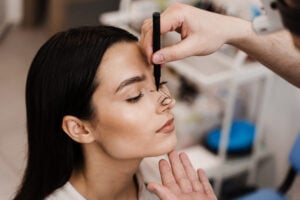The poor Brits are often teased mercilessly for their lack of pearly whites and ‘bad teeth’ – especially when compared to the broad smiles in Northern America. Popular television programs and movies often feature ‘bad British smiles’, such as Mike Myer’s unruly grin in Austin Powers. British comedians also often joke about the lack of concern for dental care.
But is their dental care really that bad?
What are the main reasons for this ‘big dental divide’?
One would think that both first world countries would have similar standards in dental care, but there are several reasons for the differences:
Culture
The Brits believe that teeth are healthy as is and will mostly only deal with dental issues when there is a potential health problem. Americans, on the other hand, seem to feel that a beautiful smile with pretty, even, and white teeth is seen as a very desirable feature.
Did you know that Americans also smile a lot more than the average Brit? This is mostly seen in service industries. In the USA, smiling at customers is an integral part of the shopping experience. British culture is much more reserved and the peppy, smiley introduction of a server isn’t given as much regard.
Hollywood
The image portrayed by Hollywood is one that features perfect white smiles. This has a profound effect on the American psyche and is an interpretation of success and beauty. While the British can be fairly vain too, they are much more conservative in their presentation. It’s only more recently that the younger UK generations are starting to pay attention to teeth presentation – also following in the footsteps of their most beloved actors and actresses.
Diet and Smoking
There’s one thing that Brits love and that’s a good cup of tea. On average, the British population drinks more beverages that leave a residue, such as tea and beer. Smoking is also more popular in the UK. These habits leave stains on one’s teeth and can often lead to cavities too.
Americans aren’t all innocent but the beer they tend to drink is lighter in colour and more coffee (which doesn’t stain as easily) is consumed than tea. Smoking in the US has also reduced drastically in the last few decades.
Dentists
In Britain, citizens have access to dental care via the NHS. This means that it is much more affordable than in the USA. The catch, however, is that only basic dentistry is covered. Cosmetic dentistry comes at a high price and must be paid out-of-pocket. There are also not as many dentists willing to perform cosmetic procedures.
In America, dentistry is not commonly covered by health plans and its common practice to take out separate dental cover – if one can afford it. Dental hygiene is still encouraged, however, and even the lower classes try to get their teeth cleaned by a dentist regularly. It’s also usual practice to buy dental hygiene tools from stores and “home use” tooth whiteners are a big industry in the US.
Fluoridated Water and Toothpaste
Unlike their American counterparts, only about 10% of people in the UK have access to fluoridated water. Across the pond, in America, you have access to fluoridated water, a multitude of fluoridated toothpastes, mouthwashes and tooth whiteners.
Health Access Inequalities
Paradoxically, health access inequalities are much higher in America than in the UK. This means that more people in the UK have access to basic dental services at a low cost while mostly the middle and upper classes have access to dental care in the US.
Marketing
Generally speaking, marketing in the US is very ‘perfection’ driven, with models and celebrities flaunting stunningly straight pearly whites. But like we mentioned above, Brits often distrust the ‘too flashy smiles’ – claiming they are all too often false.
Brits are changing, however, and US marketing trends are slowly influencing the younger generations. For example:
In the UK, celebrities, royals and politicians alike sported crooked and stained teeth. Just take a look at Tony Blair, Prince Charles and Jeremy Clarkson. But lately, younger royals, such as the Duchess of Cambridge, flaunt flawless, lovely healthy smiles. This is because cosmetic dentistry is gaining traction with the youngsters in the UK – mostly due to the connected world of social media and its influence on perceptions.
Does science support this view?
In a recent cross-sectional study[i] of British and US national oral health records (published in the British Medical Journal and ironically dubbed ‘Austin Powers bites back’), the following information was provided:
- Americans have a significantly higher number of missing teeth (this could be due to wisdom teeth extractions)
- The oral health of US citizens is not better than the English, there are only vast differences in cosmetic standards
- Oral health inequalities in the US are more prevalent than in the US
- Lower income groups in Britain have better oral health than the US, but top income levels have a much better quality of oral health in the USA[ii].
It is important to remember that an evaluation of oral health focuses more on hygiene and care than it does on aesthetics. Researchers might not include factors like tooth straightness, position and any other cosmetic features into the equation. This may lead to confusion because most tales of bad British teeth relate to cosmetic issues. Generally, a greater emphasis on overcrowding, straightening and stain removal is placed when populations consider attitudes towards teeth.














